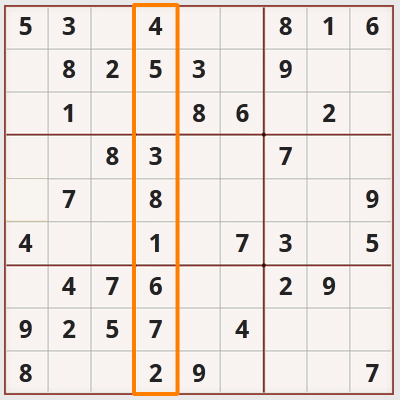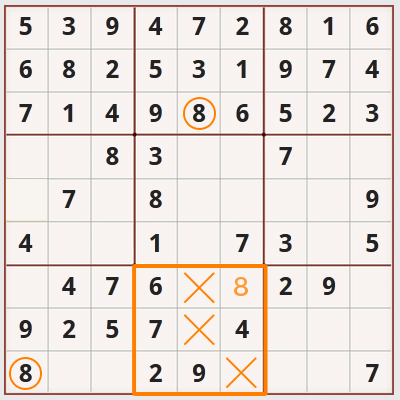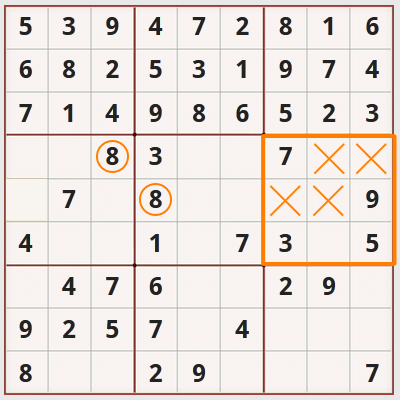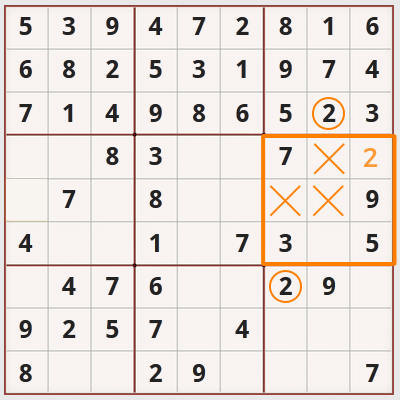Sudoku can be a fun and satisfying game in which you can spend hours playing, but it’s important to learn how to surpass the most common mistakes made by Sudoku beginners, so you can be confident in playing Sudoku for years.
Skipping out reachable opportunities
Sudoku is a game of opportunity recognition. The players should always scan the grid in searching of different opportunities, for placing a number in the empty spaces. Unfortunately most of the Sudoku beginners don’t know to find the easy options which are in front of them.
 For an example, in the grid shown in this picture, we have a vertical column (the 4th column from left to right, enclosed in orange), which has 8 out of 9 numbers, that are already on the right places. We know that we have to place only one number on the empty space. That’s an easy move for the Sudoku beginners, but there are people who are playing Sudoku for the first time and they are likely to miss this opportunity, while wasting time staring at other squares from the grid. That’s why the Sudoku players should know: start by watching the easy accessible opportunities like this one. Search for rows, columns and squares which already have many placed numbers. That will make solving the puzzle easier.
For an example, in the grid shown in this picture, we have a vertical column (the 4th column from left to right, enclosed in orange), which has 8 out of 9 numbers, that are already on the right places. We know that we have to place only one number on the empty space. That’s an easy move for the Sudoku beginners, but there are people who are playing Sudoku for the first time and they are likely to miss this opportunity, while wasting time staring at other squares from the grid. That’s why the Sudoku players should know: start by watching the easy accessible opportunities like this one. Search for rows, columns and squares which already have many placed numbers. That will make solving the puzzle easier.
Ignoring the squares
Sudoku is a game where you should place the numbers from 1 to 9 in the empty spaces in a given row, column or square. However, many Sudoku players make the mistake of focusing only on certain rows or columns. Maybe it’s much easier for the Sudoku beginners to trace and count from 1 to 9 when they are placed in a row or column?
Whatever is the reason, many Sudoku beginners make the same mistake, because they don’t spend enough time checking the squares. The squares (there are 9 of them in the grid, in which square there are 9 spaces) it’s a wonderful place providing the ability to place numbers, because every square is consisted of other rows and columns. A lot of information can be obtained, about which numbers can be excluded or added in the square, if you look at the nearby rows and columns which form the square.
 As an example in this grid, shown on the picture, there’s a square (below in the center, enclosed in orange), which has four empty spaces. After counting the existing numbers in the square we know that there are missing numbers: 1, 3, 5 and 8. If we look at the bottom row on the left and the central column above, we see the number 8 twice (enclosed in orange circles), which eliminates three spaces that can contain the number 8 (shown with orange X-s). That leads us that the number 8 must go to the top right of the square (the 8 number marked in orange).
As an example in this grid, shown on the picture, there’s a square (below in the center, enclosed in orange), which has four empty spaces. After counting the existing numbers in the square we know that there are missing numbers: 1, 3, 5 and 8. If we look at the bottom row on the left and the central column above, we see the number 8 twice (enclosed in orange circles), which eliminates three spaces that can contain the number 8 (shown with orange X-s). That leads us that the number 8 must go to the top right of the square (the 8 number marked in orange).
Ignoring the open spaces in the grid
Sudoku is a momentum game, so it’s natural wanting to focus on the part of the grid in which you have already had success in the placement of the numbers. One of the common mistakes that the Sudoku beginners make is to focus too much on parts of the grid in which they had succeeded, while forgetting the empty parts. The fact that a certain row, column or square have a lot of empty spaces doesn’t mean that you can’t make progress there.
 For an example in this grid, there’s a square to the right (enclosed in orange), which looks without a potential in placing numbers- it has five empty spaces. If we take a closer look, we might see some possibilities.
For an example in this grid, there’s a square to the right (enclosed in orange), which looks without a potential in placing numbers- it has five empty spaces. If we take a closer look, we might see some possibilities.
We know that the missing numbers are: 1, 2, 4, 6 and 8. We can trace the number 8 in two of the upper rows (circled in orange), which eliminates 4 or 5 spaces (marked with orange X-s). This means that the number 8 must go to the lower central space of the square (that is left empty).
 Once the number 8 has been added, we can see another opportunity within the same square. As shown on the grid, the other numbers left to be added are: 1, 2, 3, and 6.
Once the number 8 has been added, we can see another opportunity within the same square. As shown on the grid, the other numbers left to be added are: 1, 2, 3, and 6.
We can see the number 2 double times (circled in orange) on the left and central column, which means that the number 2 must go to the top right of the square (marked in orange).
This example shows that it’s possible to make a progress in part of the grid, which seems less promising. Don’t rely too much on places that seem promising – don’t be afraid to look from a totally different point of view.

